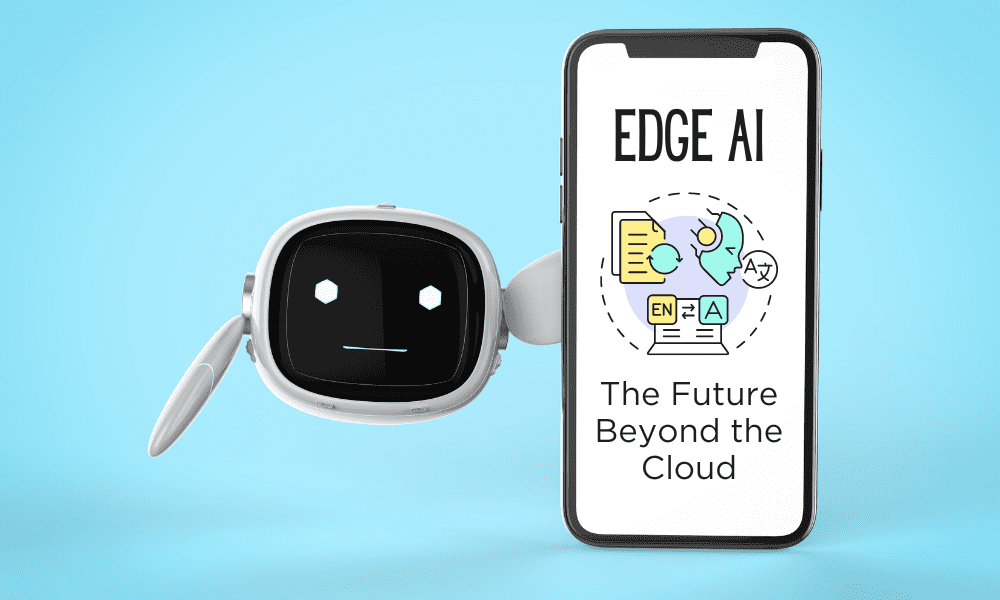
Image by Editor
The current technological landscape is experiencing a pivotal shift towards edge computing, spurred by rapid advancements in generative AI (GenAI) and traditional AI workloads. Historically reliant on cloud computing, these AI workloads are now encountering the limits of cloud-based AI, including concerns over data security, sovereignty, and network connectivity.
Working around these limitations of cloud-based AI, organizations are looking to embrace edge computing. Edge computing’s ability to enable real-time analysis and responses at the point where data is created and consumed is why organizations see it as critical for AI innovation and business growth.
With its promise of faster processing with zero-to-minimal latency, edge AI can dramatically transform emerging applications. While the edge device computing capabilities are increasingly getting better, there are still limitations that can make implementing highly accurate AI models difficult. Technologies and approaches such as model quantization, imitation learning, distributed inferencing and distributed data management can help remove the barriers to more efficient and cost-effective edge AI deployments so organizations can tap into their true potential.
AI inference in the cloud is often impacted by latency issues, causing delays in data movement between devices and cloud environments. Organizations are realizing the cost of moving data across regions, into the cloud, and back and forth from the cloud to the edge. It can hinder applications that require extremely fast, real-time responses, such as financial transactions or industrial safety systems. Additionally, when organizations must run AI-powered applications in remote locations where network connectivity is unreliable, the cloud isn’t always in reach.
The limitations of a “cloud-only” AI strategy are becoming increasingly evident, especially for next-generation AI-powered applications that demand fast, real-time responses. Issues such as network latency can slow insights and reasoning that can be delivered to the application in the cloud, leading to delays and increased costs associated with data transmission between the cloud and edge environments. This is particularly problematic for real-time applications, especially in remote areas with intermittent network connectivity. As AI takes center stage in decision-making and reasoning, the physics of moving data around can be extremely costly with a negative impact on business outcomes.
Gartner predicts that more than 55% of all data analysis by deep neural networks will occur at the point of capture in an edge system by 2025, up from less than 10% in 2021. Edge computing helps alleviate latency, scalability, data security, connectivity and more challenges, reshaping the way data processing is handled and, in turn, accelerating AI adoption. Developing applications with an offline-first approach will be critical for the success of agile applications.
With an effective edge strategy, organizations can get more value from their applications and make business decisions faster.
As AI models become increasingly sophisticated and application architectures grow more complex, the challenge of deploying these models on edge devices with computational constraints becomes more pronounced. However, advancements in technology and evolving methodologies are paving the way for the efficient integration of powerful AI models within the edge computing framework ranging from:
Model Compression and Quantization
Techniques such as model pruning and quantization are crucial for reducing the size of AI models without significantly compromising their accuracy. Model pruning eliminates redundant or non-critical information from the model, while quantization reduces the precision of the numbers used in the model’s parameters, making the models lighter and faster to run on resource-constrained devices. Model Quantization is a technique that involves compressing large AI models to improve portability and reduce model size, making models more lightweight and suitable for edge deployments. Using fine-tuning techniques, including Generalized Post-Training Quantization (GPTQ), Low-Rank Adaptation (LoRA) and Quantized LoRA (QLoRA), model quantization lowers the numerical precision of model parameters, making models more efficient and accessible for edge devices like tablets, edge gateways and mobile phones.
Edge-Specific AI Frameworks
The development of AI frameworks and libraries specifically designed for edge computing can simplify the process of deploying edge AI workloads. These frameworks are optimized for the computational limitations of edge hardware and support efficient model execution with minimal performance overhead.
Databases with Distributed Data Management
With capabilities such as vector search and real-time analytics, help meet the edge’s operational requirements and support local data processing, handling various data types, such as audio, images and sensor data. This is especially important in real-time applications like autonomous vehicle software, where diverse data types are constantly being collected and must be analyzed in real-time.
Distributed Inferencing
Which places models or workloads across multiple edge devices with local data samples without actual data exchange can mitigate potential compliance and data privacy issues. For applications, such as smart cities and industrial IoT, that involve many edge and IoT devices, distributing inferencing is crucial to take into account.
While AI has been predominantly processed in the cloud, finding a balance with edge will be critical to accelerating AI initiatives. Most, if not all, industries have recognized AI and GenAI as a competitive advantage, which is why gathering, analyzing and quickly gaining insights at the edge will be increasingly important. As organizations evolve their AI use, implementing model quantization, multimodal capabilities, data platforms and other edge strategies will help drive real-time, meaningful business outcomes.
Rahul Pradhan is VP of Product and Strategy at Couchbase (NASDAQ: BASE), provider of a leading modern database for enterprise applications that 30% of the Fortune 100 depend on. Rahul has over 20 years of experience leading and managing both engineering and product teams focusing on databases, storage, networking, and security technologies in the cloud. Before Couchbase, he led the Product Management and Business Strategy team for Dell EMC’s Emerging Technologies and Midrange Storage Divisions to bring all flash NVMe, Cloud, and SDS products to market.

